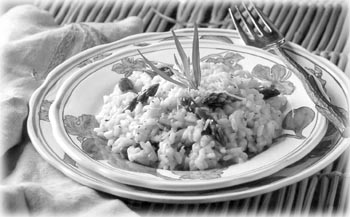![[MetroActive Dining]](/gifs/dining468.gif)
![[MetroActive Dining]](/gifs/dining468.gif)
[ Dining Index | Sonoma County Independent | MetroActive Central | Archives ]
Rice Dreams
Grain gain: Light dishes, such as this asparagus risotto, make ideal one-stop meals when paired with a salad and wine.
How risotto can change your life--
By Gretchen Giles
ADMITTEDLY a humble grain, there is more to rice than just throwing a coupla cups of water on top of it, covering the mess, lowering the heat, and turning your back for 25 minutes. There is, for example, risotto.
Requiring constant tending, risotto is the ideal informal dinner party dish, perfectly designed to ensnare that well-intentioned friend who leans into the kitchen to inquire if there is anything he can do to help. Thank you for asking, you can stir the risotto, without cease, for well-nigh on a half an hour.
And while some sweet cajoling may be needed to convince your friend to consider the upper-body strength increase associated with such an activity, the end result is handsomely paired with actually having the upper-body strength necessary to lift a fork and taste the stuff.
Medium-grained Arborio rice is the primary source for the basic, creamy wonder that is formed when the Arborio is sautéed with onions and butter, gently coddled with white wine and broth until tender, and finally infused with cheese. It can be either eaten directly out of the pan, served to complement large protein portions, used instead of pasta for a coating of pesto or as a support for a bolognese sauce, or mixed with a vegetable purée such as pumpkin for a sublime evening at home all tucked in with a napkin.
A homespun poem on a plate, risotto is also an ideal canvas for those with wild creative ideas, Martha Stewart victims who desire to theme one's evening repast lyrically to the season, or for the kind of cook with whom we are more familiar: one with a bunch of leftovers dying in the fridge.
Arborio, unlike its less easily obtained cousins Carnaroli and Vialone Nano rice, can be found at most supermarkets, even those that don't pride themselves on having a fancy-food section. Choosing Kristine Kidd's excellent Risotto cookbook (Williams-Sonoma; 1996) as our base-point for stealing recipes, the basic risotto concoction offered below is outstanding when used cold after cooking, formed into lunchtime pancakes (mix the risotto with a beaten egg for binding and lightly fry, topping with grated Parmesan cheese; serve with a green salad), or as the basis for anything that is legal and strikes your fancy.
The main difference between risotto and traditional rice preparation is that the liquid must be gently introduced to the rice: It's Elvis and Nixon, Khrushchev and Nixon, Ellsberg and Nixon.
Heat 6 cups of broth until simmering (chicken is traditional; vegetable, fish, or beef stock are fine; regular old tap water is an insult), and keep the broth hot at all times. In a deep-sided pan, sauté the chop of one medium-sized yellow onion (we like to add 2 well-washed and -chopped tender leeks here, too) until translucent, about five minutes.
To the onion mixture, add 2 1/2 cups of Arborio rice. Sauté until the grains conceive a white spot in the middle, about one minute. Add 2/3 of a cup of a kind of dry white wine that you can actually stand to imbibe in a glass, and stir until it is absorbed. Reminder: Wine that tastes ugh in a cup will taste ugh on a plate.
Beginning with 1/2 cup increments, start adding the hot broth. Stir like a demon with each addition of liquid, being sure that the stock is absorbed, over medium-low heat. Like Ward Cleaver, the rice, when all liquid has been added, should be firm but tender. The resulting creaminess is one of Arborio rice's selling points, a product of the grain's starchy composition. Add 1 3/4 cups of freshly grated Parmesan cheese, and stir until the cheese is just incorporated. We like a good, solid grind of fresh pepper, and some chopped fresh flat-leaf (Italian) parsley riding loftily on top. Salt with caution if using commercial brands of broth.
Variations might include adding fresh herbs to the onion mixture for a deepening of taste, using gorgonzola in lieu of the Parmesan, topping the dish with diced tomatoes in a simple vinaigrette, adding butternut squash, zucchini, asparagus tips, artichoke hearts, or other veggies to the onion mixture, or keeping it simple under a luscious serving of fresh shellfish. Add lemon zest, capers, garlic, Kalamata olives, plenty of parsley, and other wonders of the natural world to such seafood recipes.
[ Sonoma County Independent | MetroActive Central | Archives ]
Copyright © Metro Publishing Inc. Maintained by Boulevards New Media.

Joyce Oudkerk Pool
or at least one happy hour of it
From the Sept. 4-10, 1997 issue of the Sonoma County Independent.